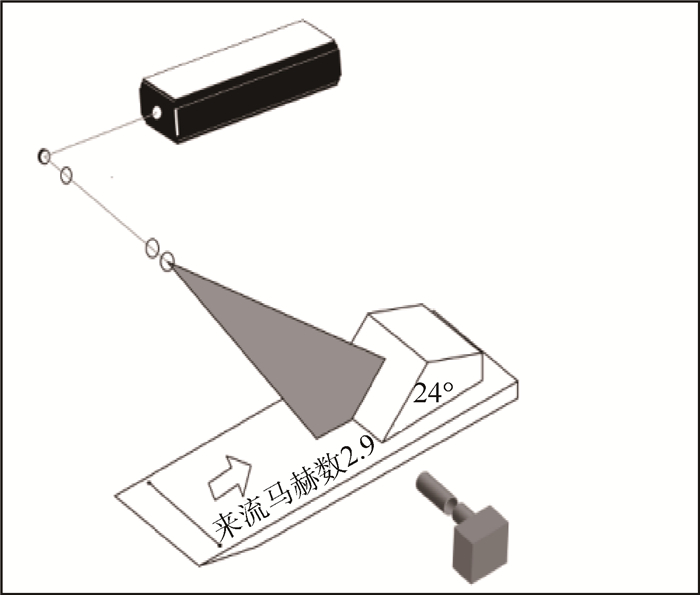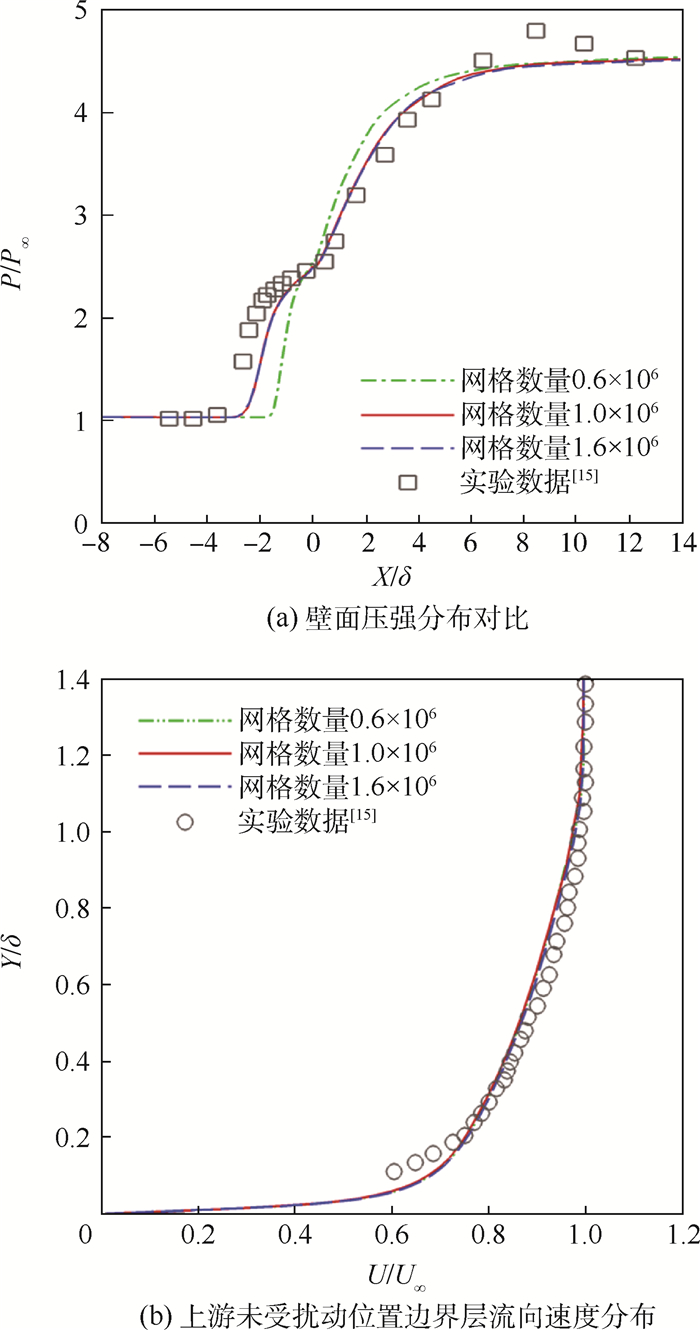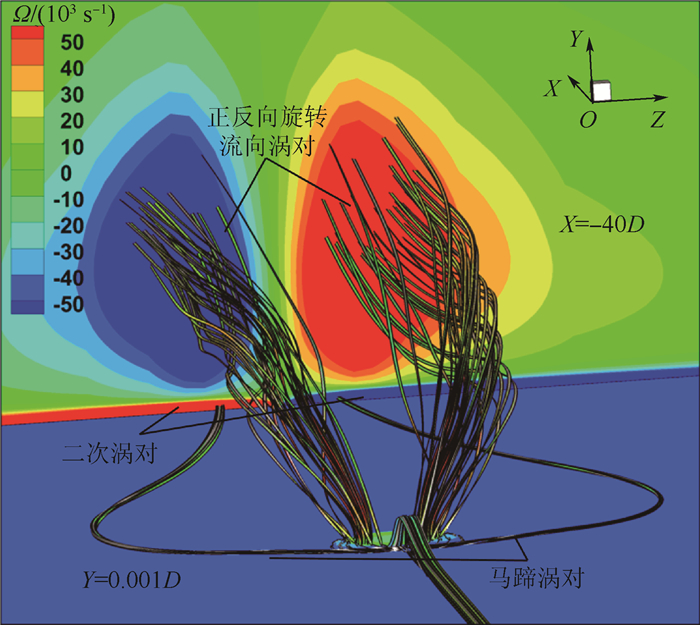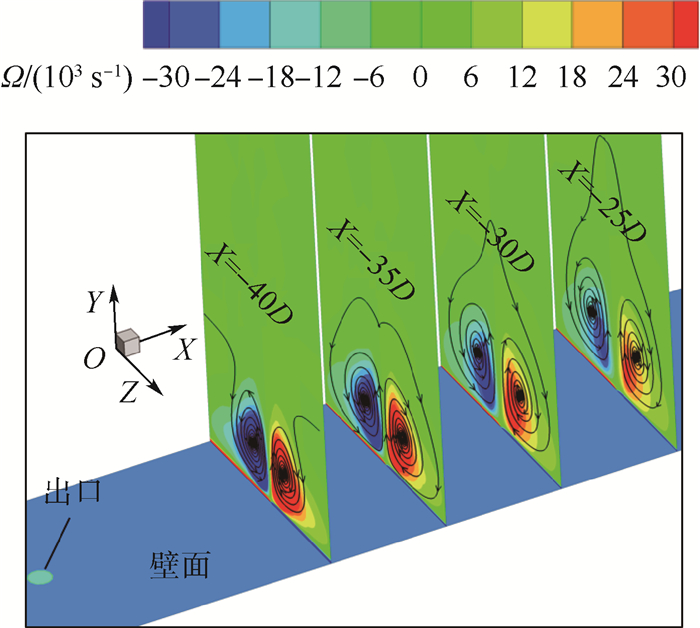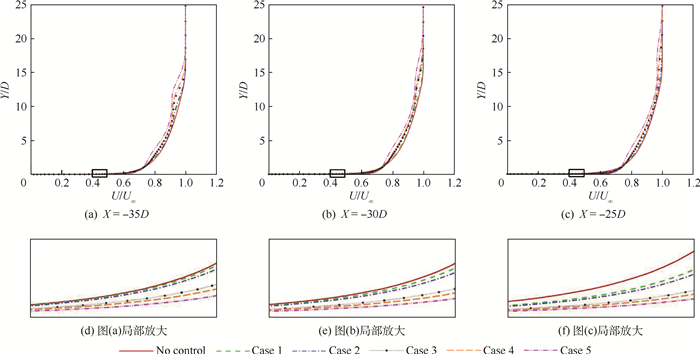-
摘要:
以24°压缩拐角为流场模型,针对不同注入总压微射流作用下来流马赫数为2.9的超声速压缩拐角流场进行了数值研究,喷射方向与来流垂直。研究表明,微射流阻挡作用下,其下游速度被减小,而减弱了分离激波强度。此外,微射流与来流耦合会产生正反向旋转流向涡对,在其下洗作用下,高能量流体被带入到边界层底部近壁面处,使此处低能流体被激活,进而增强了边界层的抗逆压能力不易发生分离,且这种激活能力会随注入总压的增加而增强。权衡控制效果和注入能量认为,注入压比(注入总压/来流总压)为0.60的微射流为最优方案,在其作用下,拐角区分离面积被减小了近70%、激波交汇点与壁面的距离被降低了近37%、分离激波强度被削弱近12%。
Abstract:An numerical investigation was conducted to study the influence of micro jet with different total injection pressure on the supersonic flow field (
Ma =2.9) for a 24° compression corner. The ejecting direction is vertical to incoming flow. The results show that the velocity of the fluid downstream the micro jet decreases due to the obstruction of micro jet, and then the decrease can weaken the separation shock intensity. In addition, high-energy fluid is brought into the bottom of the boundary layer near the wall to activate it to be fuller with the downwash effect of counter-rotating vortex pair generated by coupling of micro jet and mainstream, which leads to the stronger ability of resisting adverse pressure and the separation of the boundary layer. The activation ability enhances with the increase of total injection pressure. Weighing the control result and injection power, we think the scheme is the best when the total injection pressure ratio (total injection pressure/total freestream pressure) is 0.60. The boundary layer separation area is restrained by nearly 70%, the distance of the intersection point ofλ shock wave and the wall is reduced by almost 37%, and the separation shock intensity is weakened by nearly 12% under this scheme.-
Key words:
- micro jet /
- boundary layer /
- total injection pressure /
- vortex pair /
- separation
-
表 1 来流参数及边界层厚度
Table 1. Incoming flow parameters and boundary layer thickness
参数 来流总压/kPa 来流总温/K 来流马赫数 单位雷诺数/(107 m-1) 边界层厚度/mm 数值 680 265 2.9 6.5 15.4 表 2 各方案MJ入口参数及出口平均马赫数
Table 2. Inlet parameters and average outlet Mach number of MJ in different schemes
方案 入口总压/kPa 注入压比 入口总温/K 出口平均马赫数 No control 265 Case 1 78 0.11 265 0.84 Case 2 108 0.16 265 0.86 Case 3 308 0.45 265 0.86 Case 4 408 0.60 265 0.86 Case 5 680 1 265 0.86 注:No control为未加MJ方案。 表 3 不同方案X=-40D处最大涡量
Table 3. Maximum vorticity of different schemes at X=-40D
方案 Case 1 Case 2 Case 3 Case 4 Case 5 Ωmax/(104 s-1) 3.89 5.56 11.97 12.31 9.90 表 4 分离激波前后压强
Table 4. Pressure before and after separation of shock wave
方案 波前压强/kPa 波后压强/kPa 波后压强/波前压强 No control 21.7 40.2 1.85 Case 1 21.7 38.7 1.78 Case 2 21.7 38.3 1.76 Case 3 22.0 35.9 1.63 Case 4 22.1 35.9 1.62 Case 5 22.6 36.3 1.61 -
[1] PIOTR D, RYSZARD S.Shock wave-boundary layer interaction control by streamwise vortices[C]//Proceedings of XXI ICTAM, 2004. [2] RYSZARD S.Shock wave induced separation control by streamwise vortices[J].Journal of Thermal Science, 2005, 14(3):249-254. doi: 10.1007/s11630-005-0009-z [3] RYSZARD S, PAWEL F, JAN S, et al.Shock wave-boundary layer interaction control by air-jet streamwise vortices[C]//Proceedings of the 8th International Symposium on Experimental and Computational Aerothermodynamics of Internal Flows, 2007:1-7. [4] KUMAR R, BOTU A, ALI M Y, et al.Virtual shock shaping using microjet arrays[C]//AIAA Aerospace Sciences Meeting Including the New Horizons Forum and Aerospace Exposition.Reston:AIAA, 2010:1-8. [5] ALI M Y, AHMED K A, KUMAR R, et al.Flowfield characteristics of oblique shocks generated using microjet arrays[C]//AIAA Aerospace Sciences Meeting including the New Horizons Forum and Aerospace Exposition.Reston:AIAA, 2011, 6(3):1-15. [6] KUMAR R, ALI M Y, ALVI F S, et al.Generation and control of oblique shocks using microjets[J].AIAA Journal, 2011, 49(12):2751-2759. doi: 10.2514/1.J051148 [7] ALI M Y, ALVI F S.Three-dimensional flowfield of microjets in supersonic crossflow[C]//43rd AIAA Fluid Dynamics Conference.Reston:AIAA, 2013. [8] ALI M Y, ALVI F S, MANISANKAR C, et al.Studies on the control of shock wave-boundary layer interaction using steady microactuators[C]//41st AIAA Fluid Dynamics Conference and Exhibit.Reston:AIAA, 2011. [9] ALI M Y, ALVI F S, KUMAR R, et al.Studies on the influence of steady microactuators on shock-wave/boundary-layer interaction[J].AIAA Journal, 2013, 51(12):2753-2762. doi: 10.2514/1.J052201 [10] VERMA S B, MANISANKAR C.Shockwave/boundary-layer interaction control on a compression ramp using steady microjets[J].AIAA Journal, 2012, 50(12):2753-2764. doi: 10.2514/1.J051577 [11] VERMA S B, MANISANKAR C, AKSHARA P.Control of shock-wave boundary layer interaction using steady micro-jets[J].Shock Waves, 2015, 25(5):535-543. doi: 10.1007/s00193-014-0508-5 [12] SOUVEREIN L J, DEBIÉVE J F.Effect of air jet vortex generators on a shock wave boundary layer interaction[J].Experiments Fluids, 2010, 49(5):1053-1064. doi: 10.1007/s00348-010-0854-8 [13] SOUVEREIN L J, DEBIÉVE J F.Effect on a shock wave boundary layer interaction of air jet vortex generators[J].Progress in Flight Physics, 2012, 3:141-156. doi: 10.1007/s00348-010-0854-8 [14] YOUNG D D, JENKINS S A, MILLER D N.An investigation of active flowfield control for inlet shock/boundary layer interaction[C]//AIAA/ASME/SAE/ASEE Joint Propulsion Conference and Exhibit.Reston:AIAA, 2013:1660-1670. [15] MATTHEW J R, PATRICK B, CHRISTOPHER W, et al.Experimental study of a Mach 3 compression ramp interaction at Reθ=2400[J]. AIAA Journal, 2009, 47(2):373-385. doi: 10.2514/1.38248 -







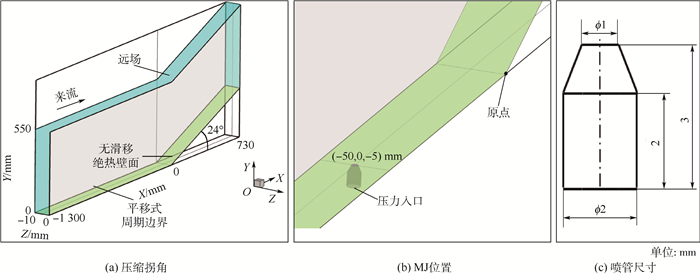
 下载:
下载:

